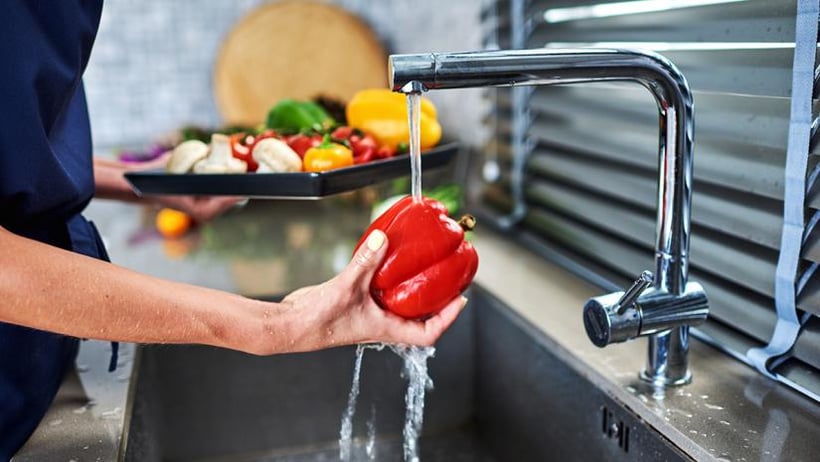
Approximately 4 million Canadians suffer from food-borne illnesses every year. Of these cases, there are over 11,500 hospitalizations and more than 230 deaths. Food-borne illnesses are caused by dangerous bacteria, viruses and parasites which can contaminate food. This contamination can come from a variety of sources throughout the food supply chain. Contaminated water or soil on a farm, contaminated processing lines at a food plant or unsafe food handling practices at food businesses are just some examples of food contamination sources. This means that food safety, including the proper handling and preparation of food, is essential to keeping food safe for consumption.
The risks of fruits and vegetables
When people think about foods that could potentially give them food poisoning, they often think about certain high-risk foods. These foods include meat and poultry, eggs, dairy products and seafood. These food items are potentially-hazardous foods that can cause food-borne illness if not kept within a certain temperature range to minimize bacterial growth or the formation of toxins that can cause food poisoning.
However, people tend to not think of fruits and vegetables when they think of foods that could make them sick. In fact, fruits and vegetables have been the source of many food-borne illness outbreaks in recent years, such as the E. coli outbreak linked to romaine lettuce, and the recent Salmonella outbreak linked to onions.
The risk with fruits and vegetables is that fresh produce can become contaminated in many ways. They can become contaminated during the growth phase by animals on a farm, by the soil or water, or by the food workers when they are harvested. They can also become contaminated during transportation and processing, as well as at the retail stores they are sold by food workers or customers. Lastly, fruits and vegetables can become contaminated during preparation in a food business by food workers or by food preparation surfaces.
It is evident that there are myriad ways that fresh produce can become contaminated and cause food-borne illness. In order to prevent a food-borne illness incident at your food business, it is important to follow food safety measures, including washing fruits and vegetables before preparation.
How to wash fruits and vegetables
Washing fruits and vegetables before preparation is a key way to remove any visible dirt or harmful pathogens that may be residing on the fresh produce. The steps are as follows:
- Clean and sanitize the sink and any other food contact surfaces/utensils that will be used.
- Wash your hands using the correct hand washing method (for 20 seconds with water and soap).*
- Cut away any damaged or bruised areas on the fruit or vegetables before handling or preparing.
- Rinse the produce thoroughly with plain running water before peeling.**
- If needed, use a clean vegetable brush to scrub the rind of firm produce, such as melons.
- Dry the produce with a paper towel.
- Place peeled or cut fruits and vegetables on a separate clean plate or container to prevent them from becoming cross-contaminated.
- Clean and sanitize the sink and any other food contact surfaces/utensils used.
*It is important to remember that the hand washing sink should not be used for anything other than hand washing. Do not use the hand washing sink to wash the fresh produce.
**Due to the coronavirus pandemic, there has been an increase in people using detergent or other soaps to clean fruits and vegetables. This stems from the concern of contracting COVID-19 from the surface of products from a grocery store. To date, there is no evidence that COVID-19 has been contracted from unwashed fruits, vegetables or other food items. However, the concern still persists and is causing people to potentially harm themselves or others by using soaps or detergents to wash their fresh produce. This can cause chemical contamination of food and can cause food-borne illness if chemically contaminated food is eaten. Only rinse fresh produce in plain running water.
The importance of food safety training
The proper handling of food, such as fresh fruits and vegetables, is a key part of food safety training. Most food businesses in Canada are legally required to ensure that all their Food Handlers are trained in food safety. This is essential to ensuring food safety in the business and preventing food-borne illness outbreaks.
The Canadian Institute of Food Safety provides nationally recognized food safety training through the CIFS Food Handler Certification Course.




